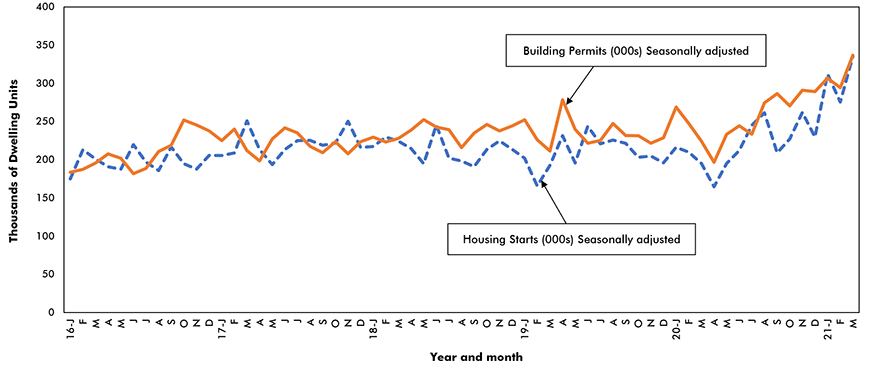With average house prices in the 10 provinces up by a minimum of +7% y/y (Newfoundland and Labrador) and by as much as +32% y/y (New Brunswick) in March, the hottest topic in the land (besides COVID-19) is the state of the housing market. However, a recent article in The Economist magazine, titled House prices in the rich world are booming, indicates Canada is not alone.
The rise in prices stems from several factors. A lagged impact of three years of above-average population growth has given a significant boost to demand. This has been amplified by the increase in pent-up demand that followed the first wave of COVID-19 in early 2020. Also, to help stimulate the economy, the Bank of Canada acted quickly to significantly ease monetary policy, causing mortgage rates to fall to their lowest level on record.
Some housing market analysts, while not dismissing the impact of an increase in demand on prices, have put more emphasis on an insufficient supply of new dwellings. This observation is reinforced by the fact that the months’ supply of existing homes for sale in Canada dropped to 1.7 in March, a record low.
COVID-19, tighter lending regs and shrinking pent-up demand should slow home sales
The impact of recently announced lockdowns to limit the spread of COVID-19 in Ontario and British Columbia, plus a curfew in Quebec, causing employment and home transactions to retreat in April, will weigh on sales in Canada’s three largest housing markets in the second quarter. In addition, the Office of the Superintendent of Financial Institutions has indicated it intends to raise the benchmark interest rate it uses to determine who can qualify for an uninsured mortgage from 4.79% to 5.25%. Finally, it is becoming increasingly likely that after posting double-digit year-over-year percentage growth for ten consecutive months, something that has happened only 3 times in the past 40 years, home sales will soon grow at a more sustainable rate.
The above-mentioned factors should cause home sales to moderate and contribute to an easing of upward pressure on prices. However, the fundamental drivers of housing demand remain strong. First, the Bank of Canada has indicated that it “is committed to holding its policy rate at the effective lower bound (i.e. 0.25%) until economic slack is absorbed so that the 2 percent inflation target is sustainably achieved”. Based on this statement we expect interest rates will remain low well into the second half of the year.
Second, although total employment in Canada, currently at 18.6 million jobs, is still -500,000 below its pre-pandemic peak of 19.1 million, full-time hiring over the past six months has increased by +300,000, meaning a nice bump in total earnings. Finally, after a hiatus in mid-2020, net international migration once again made a positive contribution to population growth in the final quarter of 2020 and should continue to do so throughout the remainder of this year and into next.
Housing starts on track to hit 34-year high in 2021
While several signs are pointing to a slowdown in housing demand, there is clear evidence that housing supply is on the upswing across the country. As of March 2021, the average number of housing units started in Canada over the past six months reached a record high of 273,000 units. On a year-over-year basis, the number of residential building permits issued through March of this year has also been a record, 298,000 units.
Across Canada’s 33 census metro areas (CMAs), the average number of dwelling units started over the past six months vs the same period a year earlier has increased in all but seven. Starts in 18 CMAs were up by double-digits; four saw triple-digit gains. Residential building permits have also exhibited widespread strength, with double-digit rates or more in all but six of the country’s 33 CMAs.
The CMAs which have exhibited the largest year-over-year jumps in starts over the past six months include Kingston, Ontario (+213%); Brantford, Ontario (+141%); Greater Sudbury, Ontario (+134%); Moncton, New Brunswick (+103%); and London, Ontario (+91.6%). Given the very strong year-to-date gains in housing starts and in building permits, groundbreakings this year should range from 225,000 to 232,000 units and from 220,000 to 230,000 in 2022.
Softening demand and increased supply will slow but not stop rising prices
The combination of a significant increase in the supply of new dwellings over the past six months and evidence that home sales are probably going to slow as we approach the mid-point of the year should cause pressure on prices to ease somewhat during 2021’s second half and through 2022.
However, it is worth noting that across the country, prices of single, semi, and row dwellings have increased on average by +23% y/y while the price of apartment condominiums is up by approximately +5% y/y. This large differential indicates that both new and existing home buyers have a strong preference for a dwelling with a private entrance, residing on its own piece of land. The disparity in pricing strength between low-rise and high-rise properties is likely to continue over the short term.
John Clinkard has over 35 years’ experience as an economist in international, national and regional research and analysis with leading financial institutions and media outlets in Canada.
Housing Starts vs Building Permits –
Canada – 2016-2021

Chart: ConstructConnect — CanaData.
Please click on the following link to download the PDF version of this article:
Economic Snapshot Vol. 19, Issue 9 – Housing demand will cool – but not overnight – PDF











Recent Comments
comments for this post are closed